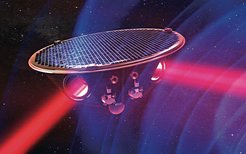Selected: The Gravitational Universe
ESA decides on next Large Mission Concepts
The Gravitational Universe will be one of the two science themes to be explored by ESA's next two Large (L-class) missions – this was decided today by ESA's Science Programme Committee (SPC).

The suggested mission to probe the Gravitational Universe is the evolved Laser Interferometer Space Antenna (eLISA). It will study the universe in a unique way – completely differently from any other space observatory – by detecting gravitational waves. Observations of gravitational waves in space will answer key scientific questions about the astrophysics of the cosmic dawn and the physics and evolution of the universe. According to ESA's decision, eLISA will be the third L-class mission, following JUICE and Athena.
“We are very pleased with this decision. It will provide revolutionary research opportunities in astrophysics and fundamental physics,” says Karsten Danzmann, designated spokesperson of eLISA, director at the Max Planck Institute for Gravitational Physics (Albert Einstein Institute/AEI) and professor at the Leibniz Universität in Hannover, Germany. “We will immediately begin to optimize technologies already being developed for eLISA. These key technologies for eLISA will get their first test in space with the launch of ESA's LISA Pathfinder (LPF) mission in 2015”, Danzmann continues.
The observation of gravitational waves in space will provide powerful insight into the fundamentals of gravity, and into Einstein's theory that predicted the waves in 1916. A gravitational wave observatory in space will open up hidden chapters in the history of the Universe by listening to the waves made by the earliest black holes, by thousands of binary stars, and possibly by the Big Bang itself. By seeing how the waves from early black holes are stretched out as they move toward us through the expanding Universe, the observatory will even study the mysterious dark energy.
The proposed eLISA mission is designed to be complementary to existing and planned ground-based gravitational wave observatories. Earth- and space-based gravitational wave observatories target different parts of the gravitational wave spectrum, searching for ripples in the fabric of space-time created by the most violent events in the Universe, such as the coalescence of black holes. Gravitational waves carry with them information about their origins and about the nature of gravity that cannot be obtained using other astronomical tools.
Video
Athena and eLISA
Background information
The Gravitational Universe
The last century has seen enormous progress in our understanding of the Universe. We know the life cycles of stars, the structure of galaxies, the remnants of the big bang, and have a general understanding of how the Universe evolved. We have come remarkably far using electromagnetic radiation as our tool for observing the Universe.
However, gravity is the engine behind many of the processes in the Universe, and much of its action is dark – it emits no electromagnetic radiation at all. Opening a gravitational window on the Universe will let us go further than any alternative. Gravity has its own messenger: Gravitational waves, ripples in the fabric of space-time. They travel essentially undisturbed and let us peer deep into the formation of the first seed black holes, exploring redshifts as large as z ~ 20, prior to the epoch of cosmic re-ionisation. Exquisite and unprecedented measurements of black hole masses and spins will make it possible to trace the history of black holes across all stages of galaxy evolution, and at the same time constrain any deviation from the Kerr metric of General Relativity.
eLISA will be the first ever mission to study the entire Universe with gravitational waves. eLISA is an all-sky monitor and will offer a wide view of a dynamic cosmos using gravitational waves as new and unique messengers to unveil The Gravitational Universe. It provides the closest ever view of the early processes at TeV energies, has guaranteed sources in the form of verification binaries in the Milky Way, and can probe the entire Universe, from its smallest scales around singularities and black holes, all the way to cosmological dimensions.
The selection process
for ESA's next large missions began in March 2013 with a Call for White Papers. More than 30 White Papers covering a broad range of topics in space science were submitted. 22 projects were presented in September 2013 to ESA's Senior Survey Committee (SSC) and the broad scientific community. Following this the SSC chaired by Dr. Catherine Cesarsky advised ESA´s Director of Science and Robotic Exploration, Dr. Alvaro Gimenez on the selection of the science themes for L2 and L3. Concluding this process the science themes for the L2 and L3 missions were selected by ESA's Science Programme Committee (SPC).
Next steps
A major step towards revealing the Gravitational Universe will be the launch of LISA Pathfinder in 2015 and the test of eLISA key technologies in space. Between 2014 and 2020, eLISA technology will be optimized, followed by the final mission selection and commitment of international partners. In 2024 the industrial implementation will begin, with the payload supplied by a European consortium which also provides the flight hardware for LISA Pathfinder. The eLISA launch is planned for 2034.













